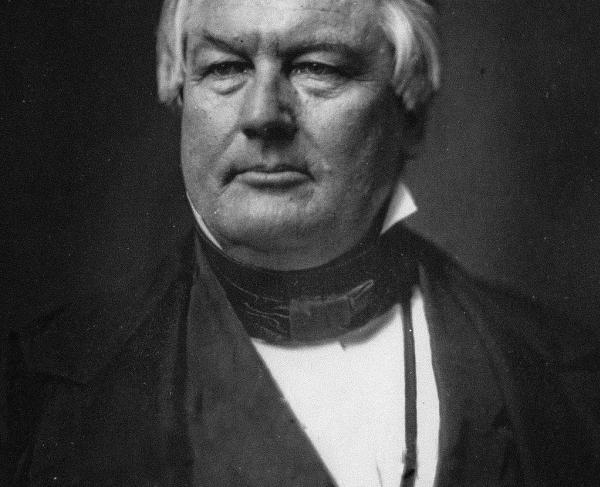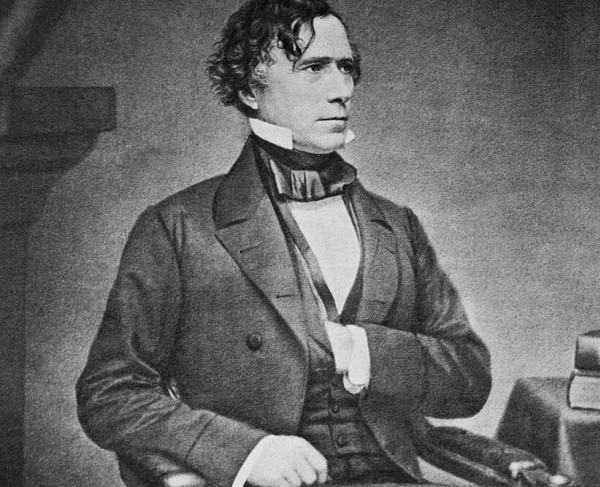Millard Fillmore

Millard Fillmore was born to Nathaniel and Phoebe Millard Fillmore, the second of eight children, in Cayuga County, New York. The Fillmores were tenant farmers, and the family endured severe poverty. With no hopes of formal schooling, his father apprenticed him to a clothmaker and then at a nearby mill. Sometime before 1819, Millard bought a share in a lending library and strove to improve himself, eventually enrolling at the New Hope Academy. Here, he met Abigail Powers, his teacher and future wife.
By 1821, Millard was teaching in East Aurora, near Buffalo, New York, where he continued his legal studies and was admitted to the bar in 1823. Three years later, he married Abigail Powers. He and his wife taught school, and he practiced law until moving to Buffalo, where Millard became interested in local politics, especially the Anti-Masonic Party.
In 1832 Fillmore successfully ran for a seat in the U.S. House of Representatives (1833-35 and 1837-43) and eventually chaired the powerful Ways and Means Committee. While in the House, he became a protégé of Massachusetts Senator Daniel Webster. In 1834, he joined the Whig Party and became a leader in its anti-slavery wing. After returning to law in 1843, he unsuccessfully sought nomination for vice president and was narrowly defeated in a bid for New York governor, due largely to his views on immigrants and his weak position on slavery. In 1846, he became involved in the founding of the University of Buffalo, becoming its first chancellor and serving until his death in 1874.
In 1847, he won election as New York State Comptroller, primarily due to his stand on policies during the Panic of 1837 and his Chairmanship of the Ways and Means Committee while in the House. As Comptroller, he successfully enlarged Buffalo’s canal facilities and regulated state-chartered banks.
With President Polk not seeking re-election, the Whig Party hoped to take the White House in 1848. Mexican War hero Zachary Taylor won the nomination on the fourth ballot, with Fillmore as his vice president. It was at this time that Fillmore's policies on slavery came into question. Northerners assumed he was against the spread of slavery. Southerners accused him of being an abolitionist. His response to a letter from Hon. John Gayle of Alabama set the record by stating, “I regard slavery as an evil, but one with which the national government has nothing to do.” Millard Fillmore was sworn in on March 5, 1849, by Chief Justice Roger B. Taney.
Fillmore officiated over some of the most contentious and heated debates in American history as the Senate argued whether to allow slavery in the territories. He presided over the Omnibus Bill of 1850, proposing California be admitted as a free state, banning the slave trade in the District of Columbia, and strengthening the Fugitive Slave Act. He was blamed for failing to keep peace in the Senate when the member from Mississippi drew a gun on his colleague from Missouri.
President Taylor died on July 9, 1850, leaving Fillmore to inherit responsibility for dealing with the national conflict. Despite the outcries from constituents within his own party, he backed the Compromise of 1850. He replaced Taylor’s cabinet members and joined forces with the moderate Whigs, who favored the Compromise. He threatened to send Federal troops into cities to put down protests. This approach eased its path to passage, which delayed the Civil War for a decade.
With Congress and the nation breathing easier, Fillmore turned to other matters. He backed federal grants for railroad construction and restored diplomatic relations with Mexico. In 1852, Fillmore sent Commodore Matthew C. Perry to Japan to establish trade, thus opening the isolationist nation to American markets. Fillmore also pledged to vigorously protect Hawaii's independence from France’s plans to annex the island.
Angered by Fillmore’s backing of the 1850 Compromise and, more importantly, the Fugitive Slave Act, northern Whigs withheld their support for his re-nomination in the 1852 Presidential election. He and his wife planned to travel after leaving the White House, but Abigail caught pneumonia and died on March 30, 1853. Grief-stricken Millard returned home and immersed himself in Buffalo's social and economic growth. He helped establish the Buffalo Historical Society, the Buffalo Fine Arts Society and the Grosvenor Library.
As the Whig Party disintegrated in the 1850s, Fillmore refused to join the Republican Party. Instead, in 1856, he accepted the nomination for president from the American Party, also called the Know Nothing Party. In the latter half of the 19th Century, there was considerable hostility towards immigrants, predominantly Irish and German, many of whom were Roman Catholics; the American capitalized on this animosity and anti-immigrant sentiment. Fillmore only won the eight electoral votes of Maryland, and James Buchanan became President. The Know Nothings soon disintegrated as a formal political party.
In 1858, Fillmore married Caroline Carmichael McIntosh, a wealthy 44-year-old widow. They honeymooned in Europe, returned to New York and purchased a mansion on Niagara Square in Buffalo. Fillmore continued to play a leading role in Buffalo’s philanthropic, civic and cultural life. He was a founder of the Buffalo General Hospital. President Fillmore loved animals and helped found a chapter of the newly formed American Society for Prevention of Cruelty to Animals (ASPCA) in March 1867.
In the 1860 Presidential election, Fillmore voted for Democratic candidate Stephen A. Douglas. After Abraham Lincoln was elected, Fillmore was outraged at the secession of Southern states. He wrote that although the federal government could not coerce a state, those advocating secession should be considered traitors. During the Civil War, he was loyal to the Union but opposed many of Lincoln's policies and his reelection. After Lincoln's assassination, Fillmore supported Andrew Johnson's appeasement towards the South.
Millard Fillmore suffered a stroke in February 1874 and died on March 8. He is buried at Forest Lawn Cemetery in Buffalo, New York.


